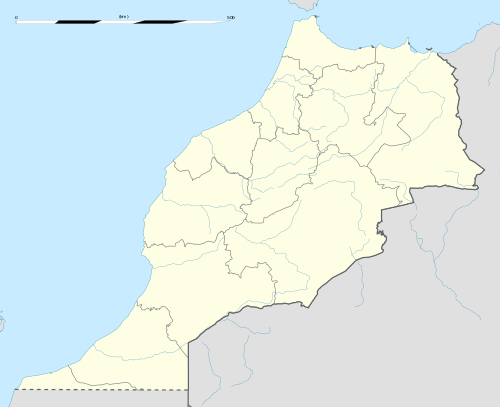Sous
The Sous region (also spelt Sus, Suss, Souss or Sousse) (Berber languages: ⵙⵓⵙ, romanized: Sus) is a region in mid-southern Morocco. Geologically, it is the alluvial basin of the Sous River (Asif n Sus), separated from the Sahara desert by the Anti-Atlas Mountains.[1] The natural vegetation in the Sus region is savanna dominated by the Argan (Argania spinosa), a local endemic tree found nowhere else;[2] part of the area is now a UNESCO Biosphere Reserve to protect this unique habitat.[3] The region of Sus is generally fertile and has a high agricultural production.
Souss ⵙⵓⵙ Sus | |
|---|---|
Region | |
 | |
 Souss Location in Morocco | |
| Coordinates: 30.08°N 8.48°W | |
| Country | |
| Region | Souss-Massa |
History
A well irrigated area, this has been one of Morocco's most fertile regions for centuries, known since at least the eleventh century for its cultivation and export of olive and sugar. The golden age of the Sus was in the seventeenth century during the era of the kingdom of Tazerwalt, when the region enjoyed autonomy and profited from both the trans-Saharan gold trade and the sale of sugar to Portuguese, Dutch and English traders. The centre for foreign trade during this time was Agadir, a city 10 km north of the mouth of the Sous river.
Population
The Sus is inhabited by Berber-speaking peoples of Imesmoden and Iẓnagen; aside from some Arabic-speaking tribes, the main inhabitants are the Susians, speakers of a distinct Berber language called Shilha language, Tacelḥit.
Bibliography
- Boogert, Nico van den. The Berber Literary Tradition of the Sous: with an edition and translation of 'The Ocean of Tears' by Muḥammad Awzal (d. 1749), Leiden: Nederlands Instituut voor het Nabije Oosten, 1997. ISBN 90-6258-971-5
- Montagne, Robert. Les Berbères et le Makhzen dans le sud du Maroc; essai sur la transformation politique des Berbères sédentaires (groupe Chleuh). Rabat: Dar Al-Aman, 2013 ISBN 9954-561-35-8.
- UNESCO Arganeraie Biosphere Reserve
References
- Allah, Redouane Choukr; Ragab, Ragab; Bouchaou, Lhoussaine; Barceló, Damià (2017-02-25). The Souss‐Massa River Basin, Morocco. Springer. p. 30. ISBN 9783319511313.
- Allah, Redouane Choukr; Ragab, Ragab; Bouchaou, Lhoussaine; Barceló, Damià (2017-02-25). The Souss‐Massa River Basin, Morocco. Springer. p. 103. ISBN 9783319511313.
- Ham, Anthony; Hardy, Paula (2007). Morocco. Ediz. Inglese. Lonely Planet. p. 389. ISBN 9781740599740.